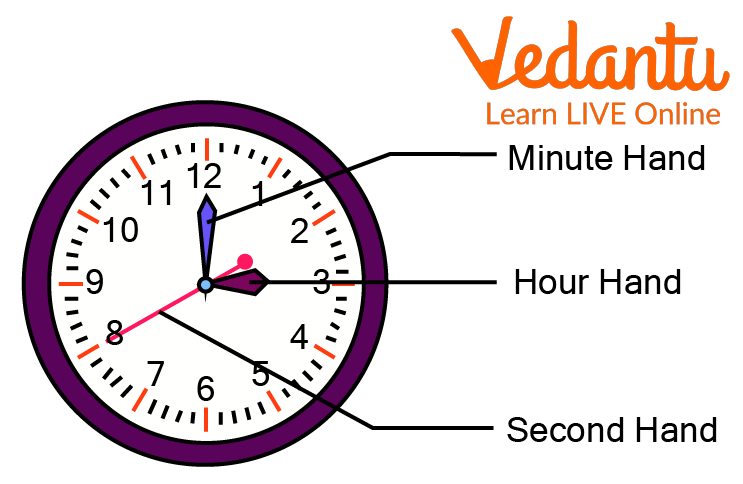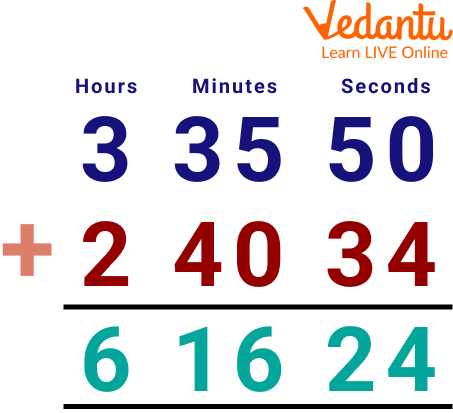




Step-by-Step Guide to Time Addition for Students
The addition of time is similar to the addition of numbers, but here, we need to consider the conversion for the addition of time. One unit of time is made up of 60 subunits and is different from the other mathematical conversion units. Here, we will learn how to convert them according to the given problem. For instance, we need to apply this notion of the addition of time to determine the total amount of time spent travelling across various forms of transportation. In this article, we will learn how to add time accurately by using the step-by-step procedure. With the help of some examples, you will learn about conversion and the addition of time.

A Clock showing Minutes, Hours, and Second hand
Time Definition
Time can be defined as the sequence of events that takes place in the present, past, and future, and it is measured using seconds, minutes, hours, days, weeks, months, and years.
A period of time equal to $\dfrac{1}{24}$ of a day is called an hour.
The S.I. unit of time is a second, and a collection of 60 seconds equals 1 minute.
A collection of 60 minutes is equal to 1 hour.
Units of Time
The basic units of time are as follows:
1 day = 24 hours
1 hour = 60 minutes
1 minute = 60 seconds
Adding Hours, Minutes, and Seconds
By following the simple steps provided below, we can add hours, minutes, and seconds.
Add the hours.
Now, minutes addition takes place and if the number of minutes is 60 or more, then do the following:
Subtract 60 from the number of minutes.
Increase the number of hours by one.
If the number of minutes is still 60 or more, repeat the same process.
After completion of the minute addition, follow the steps to perform the second's addition.
When the number of seconds is 60 or more, then do the following:
Subtract 60 from the number of seconds.
Increase the number of minutes by one.
If the number of seconds is still 60 or more, repeat the same process.
Below is an example to understand the above process more clearly.
Add 3 hours 45 minutes 30 seconds and 2 hours 20 minutes 24 seconds.
Step 1: On adding hours together, we get 3 + 2 = 5 hours.
Step 2: Doing minutes addition, we get 45 + 20 = 65 minutes. Since the number of minutes is more than 60, subtract 60 minutes from that, i.e., 65 - 60 = 5 minutes, and increase the number of hours by 1, i.e., 5 + 1 = 6 hours.
Step 3: On adding seconds together, we get 30 + 24 = 54 seconds. So, the number of seconds is less than 60.
Therefore, the result will be 6 hours 5 minutes 54 seconds.
Solved Examples
1. Compute the addition of time.
(a) 2 hours 25 minutes and 1 hour 15 minutes.
Solution: Adding hours and minutes is done by following the given steps:
Step 1: Add the hours together, we get 2 + 1 = 3 hours
Step 2: Performing minute addition, we get 25 + 15 = 40 minutes
Therefore, the result of the addition will be 3 hours 40 minutes.
(b) 3 hours 35 minutes 50 seconds and 2 hours 40 minutes 34 seconds.
Solution: Adding hours, minutes, and seconds by following the given steps:
Step 1: On adding hours together, we get 3 + 2 = 5 hours
Step 2: Doing minutes addition, we get 35 + 40 = 75 minutes. Since the number of minutes is more than 60, subtract 60 minutes from that, i.e., 15 minutes, and increase the number of hours by 1, i.e., 5 + 1 = 6 hours.
Step 3: On adding seconds together, we get 50 + 34 = 84 seconds. As the number of seconds is more than 60, subtract 60 seconds from that, i.e., 24 seconds, and increase the number of minutes by 1, i.e., 15 + 1 = 16 minutes.
Therefore, the result will be 6 hours 16 minutes 24 seconds.

Adding Hours and Minutes along with Seconds
2. Ruth started his homework at 6:30 P.M and completed it at 8 P.M. How many hours and minutes were spent by Ruth to complete her homework?
Solution: We need to subtract 6:30 from 8:00. As we know, 8 hours = 7 hours and 60 minutes. Therefore, (7 hours 60 minutes - 6 hours 30 minutes) equals 1 hour and 30 minutes. Therefore, Ruth spends 1 hour and 30 minutes completing his homework.
Practice Questions
1. Compute the addition of time 2 hrs 30 min 5 sec and 1 hr 20 min 3 sec.
Ans: 3 hrs 50 mins 8 sec
2. Add 3 hrs 45 min 3 sec and 2 hrs 50 min 4 sec.
Ans: 6 hrs 35 mins 7 sec
3. Anna plans to visit a zoological park. She takes a cab at 3.45 P.M. It takes about 1 hour and 5 minutes to reach her destination. At what time does Anna reach the zoological park?
Ans: 4:50 P.M.
Summary
In this article, we have learned about time, along with the ways to perform the addition of time. Due to the availability of time addition calculators, children have now become dependent on time addition calculators for calculating time. But by reading this article, they will learn to add the time without using a time addition calculator. We also talked about the units of time and the procedure of adding hours and minutes together. Also, we solved a few examples related to time which helped us to understand the topic better.
FAQs on How to Add Hours, Minutes, and Seconds
1. What are the basic steps to add hours, minutes, and seconds?
To add time correctly, you should follow these steps in order:
- Add the seconds: First, sum up all the seconds.
- Add the minutes: Next, sum up all the minutes.
- Add the hours: Finally, sum up all the hours.
- Adjust the totals: After adding, you must adjust or 'carry over' any values that are 60 or more, starting from the seconds column.
2. What does it mean to 'carry over' when adding time?
Carrying over in time addition is the process of converting excess seconds or minutes into the next larger unit. Since 60 seconds make 1 minute and 60 minutes make 1 hour, if your total seconds are 60 or more, you subtract 60 from the seconds and add 1 to the minutes. Similarly, if your total minutes are 60 or more, you subtract 60 from the minutes and add 1 to the hours.
3. Why do we carry over at 60 when adding time, instead of at 100 like in regular maths?
We carry over at 60 because time measurement is based on a sexagesimal (base-60) system, not a decimal (base-10) system like our usual numbers. This system originated from ancient civilizations. There are always 60 seconds in a minute and 60 minutes in an hour. Therefore, reaching a total of 60 in a smaller unit means you have completed one whole larger unit.
4. How is adding time useful in a real-life situation?
Adding time is a very practical skill. For example, if you study Maths for 1 hour 15 minutes and then Science for 50 minutes, you can add the two times together (1 hr 15 min + 50 min) to find your total study time, which is 2 hours and 5 minutes. It is also used to calculate total travel time for a journey with multiple stops or the total duration of a sports event.
5. What is the correct way to add 3 hours 45 minutes 20 seconds and 2 hours 25 minutes 50 seconds?
Here is the step-by-step method for this example:
- Add seconds: 20 + 50 = 70 seconds. Since 70 is more than 60, we write down 10 seconds (70-60) and carry over 1 minute.
- Add minutes: 45 + 25 + 1 (carry-over) = 71 minutes. Since 71 is more than 60, we write down 11 minutes (71-60) and carry over 1 hour.
- Add hours: 3 + 2 + 1 (carry-over) = 6 hours.
The final answer is 6 hours, 11 minutes, and 10 seconds.
6. What is a common mistake to avoid when adding hours, minutes, and seconds?
A very common mistake is forgetting to carry over from seconds to minutes before adding the minutes column. Students often add up all the minutes first, then all the seconds, and then try to adjust. The correct method is to always start with the smallest unit (seconds), perform the carry-over to the next unit (minutes), and then repeat the process for the minutes and hours.















